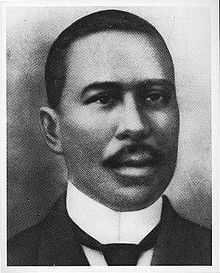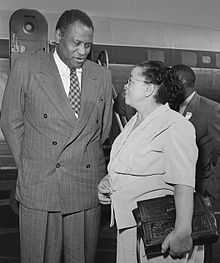California Eagle
| Ceased publication | January 7, 1964 |
|---|---|
| Headquarters |
Los Angeles, California United States |
The California Eagle (1879–1964) was one of the oldest and longest-running African-American newspapers in Los Angeles, California and the West. It started in 1879,[1] founded by John J. Neimore, who had escaped slavery in Missouri. The editor and publisher, he first called it The Owl, then renamed it The Eagle.
After Charlotta Spears succeeded him as owner in 1912, she changed the name to the California Eagle. Later marrying J. B. Bass, who became editor under her, she owned and operated the paper until 1951. In the 1920s, they increased circulation to 60,000. During this period, Charlotta Bass was also active as a civil rights campaigner in Los Angeles, working to end segregation in jobs, housing and transportation.
The newspaper was next owned for more than a decade by Loren Miller, who had been city editor. He also worked as a civil liberties lawyer and was a leader in the community. After he sold the paper in 1964 to accept an appointment as a justice to the State Supreme Court, the publication quickly lost ground and closed that year.[2]
History

The newspaper served as a source of both information and inspiration for the black community, often ignored or negatively portrayed by the predominant white press. Neimore established a newspaper to help the thousands of newly arrived African Americans adapt to life in Los Angeles, as many came from the Deep South in the Great Migration. The newspaper contained information about housing, jobs and news items relevant to the African-American community. One of the new arrivals was Charlotta Spears, who took a job selling subscriptions to the newspaper in 1910.
By 1912, Neimore was in very poor health. Spears Bass recalled in her biography of him that Neimore called her to his bedside. He made her promise to keep the newspaper alive.[3]

Spears took control of the newspaper upon Neimore's death in 1912. She owned and ran the California Eagle until she retired in 1951. After she married J.B. Bass, he was editor until his death in 1934.[3]
The California Eagle had the following platform:
- hiring of Negroes as a matter of right, rather than as a concession, in those institutions where their patronage creates a demand for labor;
- increased participation of Negroes in municipal, state, and national government;
- the abolition of enforced segregation and all other artificial barriers to the recognition of true merit;
- patronizing of Negroes by Negroes as a matter of principle;
- more rapid development of those communities in which Negroes live, by cooperation between citizens and those who have business investments in such communities; and
- enthusiastic support for a greater degree of service at the hands of all social, civic, charitable, and religious institutions
By 1925, the newspaper had a circulation of 60,000, the largest of any African-American newspaper in California. Its publishers and editors were active in civil rights, beginning with campaigns for equitable hiring, patronage of black businesses, and an end to segregated facilities and housing.
Several newspaper employees went on to become prominent figures in their own right, including T.R.M. Howard. From 1933 to 1935, Howard, then a medical student at Loma Linda University, was the circulation manager. He also wrote a regular column entitled "The Negro in the Light of History" (later changed to "Our Fight"). After medical school Howard returned to Mississippi where he became a doctor. By the 1940s and 1950s, he had become one of the wealthiest and most influential blacks in the state and was a leading civil rights leader. He was later a mentor of Medgar Evers and Fannie Lou Hamer. In addition, he played a key role in finding evidence and witnesses in the Emmett Till murder case.[4]
In 1951 Charlotta Bass sold the California Eagle to Loren Miller, the former city editor.[5] Miller was a Washington University, Kansas law graduate. After he relocated to Los Angeles in 1930, he began writing for the Eagle and eventually became city editor. He earned a reputation in the black community as an articulate and outspoken defender of African Americans.
Miller continued in the tradition of publishing an activist paper. He was a civil liberties lawyer, with a particular interest in discrimination and housing. In 1945, Miller represented Hattie McDaniel and won her case against the "Sugar Hill" restrictive covenant case.[6] His work against restrictive covenants and other racial segregation practices led to his appointment in 1963as Superior Court of California judge by former Governor Edmund "Pat" Brown.[7]
The partial list of the employees and contributors at The California Eagle in 1957 were;
- Francis Philip Waller Jr., advertising & circulation;
- Abie Robinson, city reporting & general news;
- Roy Smith, sports reporting;
- Calme Russ, office management;
- Maggie Hathaway, society reporting & civic/church matters; and
- Anthony Funches, began as a copy boy, also doing cleaning, circulation/distribution.
The offices were located at 4071-4075 South Central Avenue.[8]
In 1963, Miller sold the paper to fourteen local investors in order to accept his appointment as judge. The California Eagle initially increased circulation from 3,000 to 21,000.[9] But, within six months the paper had to close. The paper rapidly deteriorated and on January 7, 1964, the California Eagle ceased publication after 85 years.
Notable people
- Robert C. Farrell (born 1936), journalist and member of the Los Angeles City Council, 1974–91
Footnotes
- ↑ "John J. Neimore, founder and editor of the California Eagle". USC Digital Archive.
- ↑ Hoffman, Claire Giannini (April 2007). California, Past, Present, Future. California Almanac Co., Original from the University of California.
- ↑ 3.0 3.1 Charlotta Bass: Her Story, Charlotta Bass and the California Eagle, Southern California Library for Social Studies and Research, accessed 13 March 2011
- ↑ David T. Beito and Linda Royster Beito, Black Maverick: T.R.M. Howard's Fight for Civil Rights and Economic Power (Urbana: University of Illinois Press, 2009), pp. 25-38.
- ↑ Sides, Josh (2003). L.A. City Limits: African American Los Angeles from the Great Depression to the Present. p. 20.
- ↑ Watts, Jill (2005). Hattie McDaniel: Black Ambition, White Hollywood. New York, NY:: HarperCollins. p. 328. ISBN 0-06-051490-6.
- ↑ "California Eagle History: Charlotta Bass and the California Eagle". Southern California Library for Social Studies and Research. Retrieved 13 March 2011.
- ↑ Laura Pulido; Laura Barraclough; Wendy Cheng (24 March 2012). A People's Guide to Los Angeles. University of California Press. p. 184. ISBN 978-0-520-95334-5. Retrieved 15 September 2012.
- ↑ "California Eagle Photograph Collection".
Additional reading
- Douglas Flamming, Bound for Freedom: Black Los Angeles in Jim Crow America. Berkeley: University of California Press, 2005.
- Josh Sides, L.A. City Limits: African American Los Angeles from the Great Depression to the Present. Berkeley: University of California Press, 2003.
- B. Gordon Wheeler, Black California: The History of African-Americans in the Golden State. New York: Hippocrene Books, 1993.
- Scott Kurashige, The Shifting Grounds of Race: Black and Japanese Americans in the Making of a Multiethnic Los Angeles. Princeton, NJ: Princeton University Press, 2008.